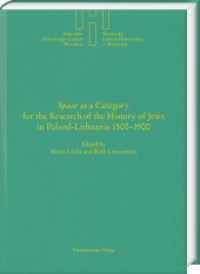Full Description
This textbook covers legal translation themes by types of legal documents. The three parts of the book are devoted to the translation of legislative documents, contracts, and court documentation. This textbook uses a new approach to train students of legal translation, which can be used to teach translation from English to any other language. This approach combines legal and linguistic perspectives of the study of legal documents, and includes machine translation and artificial intelligence (AI) tools and corpus methods. The book instigates a profound understanding of the functions, structure, and linguistic characteristics of document types. Examples of translation from English to Italian, German, Ukrainian and Polish with analysis will help students compare different translations and suggest their own translation of the same examples into their target language (TL). The book also provides exercises to develop translation skills within the legal domain, focusing on developing students' research skills, their ability to substantiate the choice of target language terminology, identify translators' false friends, cope with the issues of syntax and morphology, and apply various translation strategies and techniques. The exercises also include a comparative analysis of post-editing of machine translation and AI-generated translations with their own translations.
Contents
List of tables
List of figures
Preface
Acknowledgements
Introduction
1 Legal translation today - between law, language, and technologies
1.1 Practical aspects of legal translation
1.2 Legal systems and translation
1.3 Translation strategies and techniques
1.4 Modern technologies in translation
Part 1 Translating legislation
2 General information about legislation and its translation
2.1 The purpose of legislation and its translation
2.2 Structure, classification, and hierarchy of legislative texts
2.3 A translator of legislation
2.4 When legislative acts need to be translated
3 Translating EU legislative acts
3.1 Types and general characteristics of EU legislative acts
3.2 Machine translation in EU institutions
3.3 Challenges of translating titles, subject matter, scope, and definitions of EU legislative acts
3.4 Exercises
4 Translating UK legislation
4.1 Primary and secondary legislation in UK law
4.2 Structure and linguistic characteristics of Acts of Parliament of the UK, Scotland, and Northern Ireland
4.3 Translating different structural parts of UK legislative acts
4.4 Grammatical issues of translating UK legislation: infinitive phrases and clauses
4.5 Exercises
5 Translating US legislation
5.1 The hierarchy of US legislative acts
5.2 Translating the Constitution
5.3 Grammatical challenges of translating passive voice structures
5.4 Exercises
Part 2 Translating contracts
6 General information about contracts and their translation
6.1 The nature of contracts
6.2 The goals of signing contracts
6.3 Contracts in common and civil law jurisdictions
6.4 Structural elements of the contract
6.5 Language of contracts and translation problems
6.6 When contracts need to be translated
7 Translating contracts for an unlimited number of users
7.1 Types of contracts for an unlimited number of users
7.2 The functions of a website's "Terms of Use"
7.3 Common provisions included in the "Terms of Use"
7.4 Translation of contracts with an indefinite number of users
7.5 Language categories. Language of obligation, permission, and prohibition
7.6 Limitation of liability and disclaimer clauses
7.7 Exercises
8 Translating service provision contracts
8.1 Functions and goals of the service contract
8.2 Common clauses and structures of service provision contracts
8.3 Challenges of translating service provision contracts. Titles
8.4 An introductory clause and its translation
Language of performance as a translation problem
8.6 Exercises
9 Translating building construction contracts
9.1 Specific features of a building construction contract
9.2 Common provisions and structure of a building construction contract
9.3 Archaic words and phrases in legal English as a translation problem
9.4 Noun premodification as a specific feature of the English language and methods of its translation
9.5 Exercises
Part 3 Translating court judgments and opinions
10 General information about courts and court documents
10.1 Functions of courts and court documents
10.2 Court documents in different law systems
10.3 Definitions of "judgment"
10.4 When court judgments and opinions need to be translated
11 Translating judgments of the European Court of Human Rights
11.1 The history, jurisdiction, and structure of the European Court of Human Rights
11.2 Structural parts of ECtHR judgments and their translation
11.3 Translation of the circumstances of the case as a narrative
11.4 Relevant legal framework and practice and the "Law" section
11.5 Grammatical challenges of translating ECtHR judgments: tense forms of the verbs in different sections of the judgment
11.6 Exercises
12 Translating UK court judgments
12.1 UK judicial system, structure, and hierarchy
12.2 Participants in the proceedings
12.3 Pre-translation analysis of the judgment
12.4 Structural elements of UK judgments and their translation
12.5 Exercises
13 Translating US Supreme Court opinions
13.1 The judicial system of the United States
13.2 Judicial opinion as a post-trial document: definition and types
13.3 Common structural elements of the US judicial opinions and how to understand them to translate properly
13.4 References and citations: how to understand abbreviations and translate them correctly
13.5 Participants in the US Supreme Court
13.6 Grammatical challenges of translating gerunds and gerundial structures
13.7 Exercises
Glossary
Grammatical topics
Index








